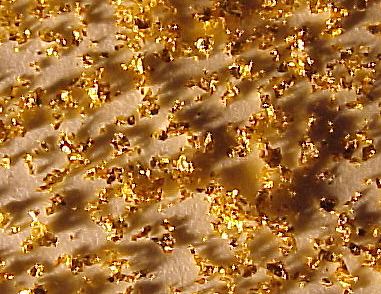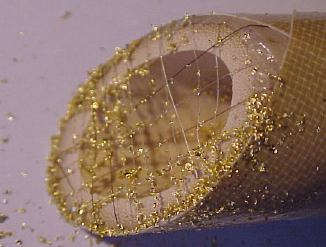A 'Scattered Gold' Background (entry by David Bull)
Many of the old woodblock prints in the genre known as 'surimono' made use of metal 'pigments' in their manufacture. Metals were used as leaf, powder, flake, or filings, and, when used with discretion, could add quite a feeling of luxury to the print.
On this page, I will demonstrate a basic technique for creating a background of 'torn' flakes of gold scattered across the paper ...

This effect is most commonly used in papers for calligraphy here in Japan, but now and again, one sees it used on a woodblock print.
(Many thanks to Mr. Hisashi Komuro for demonstrating for me the techniques illustrated here.)
The flakes are usually not purchased in that form, but are made up by the printer himself from standard gold leaf. The tools one needs for this are simple - a strainer (sieve) with a good stiff mesh, and a brush with short and stiff bristles.
To make enough flakes to cover the background of 200 prints of about B5 size, about ten standard sheets of gold leaf are needed. Before each sheet is 'processed', it must be lightly - very lightly - dusted with talc.

Without this dusting, the flakes would stick together in the applicator tool; with too much talc dusted onto the leaf, the flakes will not adhere well to the paper.
After each leaf is dusted, place it into the strainer.

Use the stiff brush and rub in very tight circles over one spot on the leaf. Have a clean sheet of paper underneath to catch the flakes. After a moments rubbing, the leaf at that point will have been torn to shreds and forced through the mesh. Move to another spot and rub again ...

Move around the leaf, 'chewing it up' section by section, until all the gold has been turned into flakes. Try to avoid having the leaf fold over itself in the strainer, as this will cause it to adhere to itself, producing 'lumpier' larger flakes.
When all the sheets have been processed, you will have a pile of flakes, known in Japanese as sunago. (As the flake size is determined by the size of the mesh on the strainer, decorators in gold who do a lot of this work keep an assortment of strainers (furui) on hand, as well as a collection of takezutsu in different sizes ... It is also common to use a 'two-pass' process - passing the leaf through a strainer with a larger mesh first, and then passing the resulting sunago through one with a finer mesh.)

A close-up look shows them to be torn and twisted little fragments of gold leaf. They are extremely light; a sneeze would be disastrous, but even strong breathing will send them spinning up into the air ...

The sunago will be applied to the paper with the use of a tool known as a takezutsu, made from a segment cut from a piece of bamboo (open at both ends - one end cut with a bevel shape):

The bevelled end of the tool is criss-crossed with a mesh of hairs:

These hairs (which I collected from myself) are glued in place over the mouth of the tool and protected by strips of tape. The openings in the mesh should be just a bit larger than an average flake.
Once the tool is ready, the sunago is 'loaded' into it by pouring the flakes into the open back end of the tool.

Continued on Page Two ...